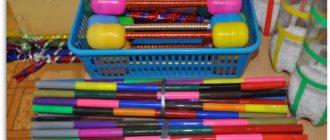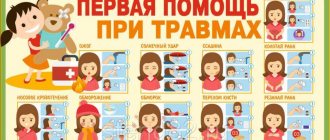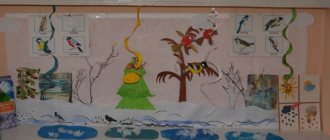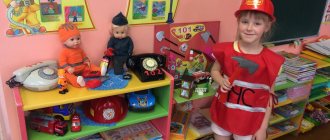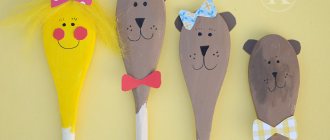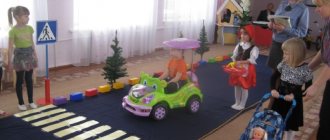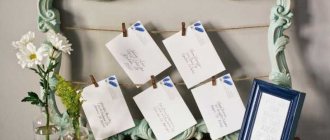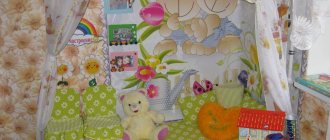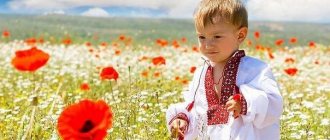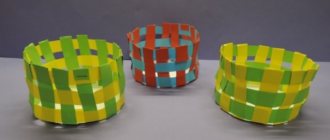Do-it-yourself non-standard physical education equipment in kindergarten
Content
It is very important for every parent that in kindergarten the child not only spends time when adults are busy, but also develops. To do this, we will make non-standard equipment for physical education and our children will achieve high results.
It is before school age that all vital processes in the body are formed in a child. Therefore, physical education classes and children's educational games are of great importance in kindergarten. In this article you will find useful tips on how to create original objects for children's development. The most important thing is that they are created with your own hands from available materials that can be found in every home and are completely safe. And most importantly, if you are a resourceful and active parent, you can even make such masterpieces for the development of your baby at home or in the country.
1. Walkway for the prevention of flat feet. It is made very simply from everything you can find. For example, from egg trays (for better perception, each tray is painted a separate color), or plastic lids. You can also use other materials for such tracks: strands, beads, buttons, etc.
2. To prevent coordination. You can build a balance beam from wood.
3. To develop fine motor skills. Various winding sticks are made. These are ordinary wooden sticks, where one end of a rope or ribbon is tied, and on the opposite side some trinket.
4. To develop dexterity. You can build two towers from durable material and mugs from plastic boxes from kinders. Or make balls from socks filled with sand and plastic targets. The main task of the baby is to hit the target, you can complicate the tasks according to the color purpose. You can use plastic bottles (to make pins out of them) and the same bags of sand for throwing at the pins.
5. To develop breathing, bottles with a straw inside are made. The bottle contains foam. When the child blows into the tube, the foam will rise. Or a table football field for blowing paper balls into the opponent’s goal.
6. To develop dexterity and synchronize movements, use the game “Catch the Ball.” They are made from a plastic bottle and a ball (kinder base) on a string.
7. To prevent visual impairment - a visual track.
8. For physical exercise: dumbbells made from plastic bottles, jump ropes made from yogurt bottles and shoelaces, and a metal bow.
Non-standard physical education equipment, with the right approach, will help a child develop and grow even in kindergarten. Make it yourself and contribute to the future of your children.
Video:
You are not authorized to post comments.
be-missis.ru
USE OF PHYSICAL EDUCATION EQUIPMENT IN KINDERGARTEN
To carry out the tasks of physical education in preschool institutions, physical education equipment is used: stationary and portable; physical education equipment for sports institutions and games, physical education aids.
Requirements for physical education equipment:
- all equipment and inventory used on the site and indoors must comply with the rules for protecting the life and health of children, hygiene and aesthetics requirements;
— the dimensions and designs of equipment and aids must correspond to the anatomical and physiological characteristics of children and their age.
The sports ground and gym in every kindergarten must be equipped with everything necessary. The physical training ground must have: a pit with sand for long jumps (dimensions 4x4, depth - 40 cm); arches for climbing (height - 40-60 cm); Swedish wall (height -2.5-3 m); balance beam (length -5 m, height - 40 cm); racks for stretching the net (for playing ball, badminton; different types of pyramids for climbing; running track (length - 30 m); targets of various types; football field (length - 20 m, width -15 m).
The equipment of the gym consists of: a gymnastic wall (height - 2.5 m); gymnastics board (length - 2.5 m, width - 20 cm); gymnastic bench (length - 3 m, height - 20, 25, 30 cm); targets of different types; racks and bars for jumping; aids for performing physical exercises (balls, sandbags, hoops, ribbons, gymnastic sticks, cubes, rattles, cords, etc.); simulators.
To ensure the effectiveness of the use of physical education equipment, first of all, it is necessary to select and combine different types of it into sets, taking into account the specifics of placement in different rooms and outdoors: in a separate gym of a kindergarten, a music and physical education hall, a group room without bedrooms and with bedrooms, a dressing room room, physical education area, group area, etc.
158
It is advisable to include in the kit: stationary equipment (1-5 units), a set of physical education aids, consisting of balls, hoops, jump ropes of different sizes; portable (stepladder, slide, rocking bridge); prefabricated structures that make it possible to transform the parts of the kit; physical education aids that can be hung, attached, combined with a stationary one; parts for combining with stationary and portable equipment (special hooks, latches, tapes); additional physical education aids in the form of visual landmarks (planar paths, geometric shapes, etc.); game details-attributes (steering wheels, badges).
It is very important to provide convenient placement of equipment so that children have the opportunity to approach it from different directions without interfering with each other.
The positiveness and frequency of use of equipment increases if each of its types is used for a wide variety of movements. So, for example, on a gymnastic bench and board you can walk, run, crawl in different ways, perform all kinds of actions with balls, etc.
One of the techniques for increasing the effectiveness of physical education equipment is to create novelty. Children get tired of monotony, they stop noticing their most favorite toys. Novelty is created by changing portable equipment, placing additional (mounted, attached) equipment on stationary and portable equipment; combining different aids into unique complexes (obstacle courses, paths, fences, houses); permutations of benefits in different spatial arrangements.
Interesting techniques of novelty, in which physical education equipment turns into play equipment. So, for example, in the summer on the site it is enough to use ordinary awnings. To make them, you can use any fabric (tent, cotton flannel), preferably in bright colors. To quickly and conveniently secure the awning, you can sew buttons, ties, and ribbon to it. The awning can be decorated with a plot applique and windows can be cut out.
Options for using physical education equipment (see table).
159
Physical education equipment is temporarily (for one day or one walk) turned into play equipment. Once you attach a strip of fabric to the vine, a house, hut, tent, theater area and much more are ready.
Different scenes can be played out on vertical and inclined stairs. An ordinary ladder can be turned into a rocket or a spaceship. A special tent-target is fixed between two ladders, trees, on a horizontal bar, put on a bench, or a block of wood. If you fasten the awning on top or on the sides of the collars, then it will be a tunnel, or maybe a house, a garage, a zoo. You can play steam locomotive and bus here.
The rational use of physical education equipment has its own specifics depending on the age of the children.
In younger groups, it should contain a play element, giving the child the opportunity to freely move from “purely motor” activity to play and vice versa, creating conditions for his fullest self-expression in activity. You can ensure a variety of motor activities using a very small number of simple aids: firstly, arranging them differently; secondly, teaching children all the basic movements on each of the benefits; thirdly, developing in children the ability to perform all familiar movements in each manual; fourthly, uniting children in joint movements with one aid (jump rope, ball, hoop for two).
When adding aids to the group, you should arrange them slightly differently each time: in another part of the room, in a different spatial arrangement (for example, a portable ladder can be placed on the floor, with its ends on two chairs, inclined, sideways), supplement the main aids with small details ( put a cube on the board for stepping over, a ball on the gymnastics bench that will “tell” the children a new movement); gradually combine different aids into sets (for example, a board, several cubes, an arc are arranged in a row in the center of the group room, etc.).
Physical education equipment is added to the group depending on the time of day, the nature of the children’s previous and upcoming activities.
So, during the morning reception, benefits are calculated for moderate, “average” mobility of children. Uchity-
161
There is one more circumstance: the teacher is busy receiving children, he cannot pay due attention to guiding motor activity, therefore preference is given to aids for simple movements that are well known to children and do not require insurance: this is a cord, a jump rope, a rope; regular board, ribbed, inclined; cubes, pins, arcs, etc.
After breakfast and during a walk, children should actively rest before “sedentary” classes (in this case, they will better learn the lesson material), and largely satisfy the need for movement. The teacher has the opportunity to pay attention to each of the children a little more than in the morning. Therefore, benefits at this time are more complex, requiring special supervision or guidance from the teacher.
In the afternoon, children’s motor activity is organized immediately after sleep, as well as after an afternoon snack, during a walk. Here she can be active, highly emotional, and creative. It is advisable to give preschoolers simple objects with which they can move a lot and in different ways (balls, hoops, different in size, made of different materials).
Preference should be given to prefabricated structures, so that you can, at your discretion, turn the physical education complex into a “fire escape,” “observation tower,” or “ship mast.”
By effectively using physical education equipment, the teacher will provide varied and interesting activities for children.
APPLICATION
Non-traditional physical education equipment (do-it-yourself)
"Magic rug"
This equipment is made of plastic bottles with caps based on drape fabric.
Designed for barefoot walking, correction and prevention of flat feet, hardening. It is used for physical exercises, during wake-up exercises, and joint sports events with parents.
"Footprints and palms"
This equipment is made from pieces of linoleum.
Used for outdoor activities and entertainment, to reinforce the concepts: “right leg”, “left leg”, “right hand”, “left hand”. Promotes the development of coordination of movement, memory, dexterity, strengthening the muscles of the legs and arms, attention.
"Breeze in a Bottle"
This manual is made from a plastic bottle, colored paper, and cocktail straws.
Used for breathing exercises. Develops respiratory organs.
"Sultans"
Made from sticks and colored ribbons and ribbons.
Designed for performing general developmental exercises, breathing exercises, organizing outdoor games, and competition games. Promotes the development of respiratory organs and trunk muscles.
"Bilboke"
Made from plastic bottles, fishing line, Kinder Surprise capsules, for decoration: colored adhesive paper.
Designed to hit the target. Develops eye, attention, reaction speed, manual dexterity.
"Sports cubes"
Made of plastic cubes, paper with silhouettes of a person performing various exercises.
Intended for use in independent play activities, organized educational activities, and for working at home with parents. Helps strengthen body muscles, develop general developmental exercises, attention, coordination of movements, and speed of reaction.
"Nimble Mouse"
Made from a ball, a mat glued to a wooden base, a spring, and a mouse toy.
Designed to hit the target for playing individually, in pairs, or as a team. Develops eye, attention, reaction speed, manual dexterity.
Expander
Made from five-liter plastic cans and elastic.
Designed to develop strength.
Dumbbells
Made from plastic bottles, colored tape and sand (or other material for filling them).
Designed to develop strength.
Multi-colored balls
Made from small plastic bottles, filled with colored rain, candy wrappers, etc.
Designed to perform general developmental exercises, basic types of movements, massage and self-massage, prevention of flat feet, development of fine motor skills, used as substitute objects for role-playing games.
Tunnel
Made from aluminum hoop and thick fabric.
Designed for climbing. Used in outdoor games, when performing basic types of movement, in role-playing games.
Walkers
Made from painted wooden blocks and clothesline.
Designed to perform basic types of movement, to develop movement coordination, and for independent play activities.
Sports bags
Made of thick fabric and filled with beans, you can use other filler (small pebbles, beads, peas, etc.)
Designed to perform general developmental exercises, basic types of movements, massage and self-massage, and prevention of flat feet.
dohcolonoc.ru
The importance of physical education and sports play equipment for the comprehensive development of children
Full and comprehensive development and education is impossible without properly organized and sufficient motor activity for preschool children, which has a huge impact on the health and physical development of the child. The growing body of a child needs movement, and the satisfaction of this need is the most important condition for his life and development.
The expedient selection and rational use of physical education equipment in the process of optimizing the physical activity regime of children in a kindergarten will contribute to the development of the motor sphere of children and their comprehensive development.
At the initial stage of mastering various movements, diverse poses, and objective actions, an important role belongs to adults. They create conditions for activating children’s motor activity while they are awake, making extensive use of a variety of bright toys, objects, and aids that stimulate them to perform different movements. Kids reach out to an object they like, try to cover some distance in order to get it, and then try to act with it. Through actions with different objects, the child becomes familiar with the object environment around him. Gradual mastery of different types of movements helps expand the child’s capabilities in understanding the world around him. In the process of manifestation of motor activity, the child quickly establishes conditioned reflex connections in the cerebral cortex, and comprehensive development occurs more intensively.
The motor activity of a child when achieving the goal of any action, for example, throwing a ball into a basket, maintaining balance on a balance beam, walking on a gymnastic bench, soft boom, cycling, skiing, is determined by intellectual-sensory, cognitive, as well as emotional-volitional and child's play activity.
In the process of performing various types of exercises using aids, children develop motor skills (skiing, jumping from hoop to hoop, jumping from objects, crawling on all fours between objects, climbing a gymnastic wall, etc.).
When using physical education equipment, variable and complicated conditions can be created for performing various game exercises. For example, children, overcoming an obstacle course consisting of various soft modules, perform many movements (walking and running on an inclined boom, crawling on a gymnastic bench, crawling under arches, jumping on a trampoline, etc.). At the same time, they show agility, endurance, good reaction, as well as courage, determination and resourcefulness.
A set of general developmental exercises with various aids and objects (ball, hoop, gymnastic stick, etc.) can have a huge impact on the development of different muscle groups and strengthening muscle tone.
To strengthen the muscles of the foot and prevent flat feet, various massagers and small objects (rings, sticks, balls, ribbed and massage boards) are used.
In the process of performing game exercises, children gain knowledge about the properties of various objects and aids (shape, color, weight, quality, material), become familiar with the features of movement in space, and the directions of movement. It should be noted the positive role of various physical education aids in children’s outdoor games and exercises for the perception of space and time, including the formation of skills and abilities to navigate the environment. Children, showing motor activity, act in a certain space, which can be different in size and shape, and subject saturation. During classes in a group area, sports ground or in a nearby forest, the field of activity for children is quite wide. They move a lot on playgrounds, running tracks, jumping areas, and on the ski track. However, the space for children's physical activity during physical education classes held in the gym is more confined, since it is limited by the size and shape of indoor spaces - group rooms, physical education and gyms, swimming pools.
In any of the listed spaces, the child determines the location of some objects in relation to others, as well as in relation to himself, and at the same time he learns all this in the process of motor activity based on sensation, touch, visual perception and speech. Under different conditions, children simultaneously develop movements and spatial orientation.
Diverse cognition of spatio-temporal relations and the objective environment occurs through active movements performed by children with different aids. Some physical exercises can be performed with small physical education aids (rubber ring, flag, rope, stick, hoop, ball), other exercises can be performed on a gymnastic roller, wall, balance beam, sled, skis, etc. or near them (at the gymnastic wall , benches, near a log, etc.).
Requirements for sports equipment, its classification.
Physical education equipment must meet pedagogical, hygienic, and ergonomic requirements. The use of equipment should contribute to the effective organization of the pedagogical process, allowing one to successfully solve didactic, health-improving and educational tasks.
In a preschool institution, it is necessary to have a sufficient amount of various physical education equipment to ensure the participation of all children in the group (subgroup), their physical activity in the process of organized classes and outdoor games, as well as in the independent activities of children in their free time.
It is important that the dimensions of the equipment correspond to the anthropometric indicators of children. Only in this case can comfort of motor actions in a developing environment be achieved. The dimensions and weight of portable equipment must be commensurate with the capabilities of the children and can be moved by the children themselves.
One of the necessary requirements is to ensure the safety of children when using the equipment. Each benefit must be durable, reliable, and suitable for use. The reliability and sustainability of large benefits must be ensured.
Physical education equipment, aids and equipment for preschoolers are made from different materials. It is important that they have a hygienic certificate and do not have a harmful effect on the body of children. It should be noted that for preschoolers, gymnastics and play equipment made of wood is preferable. For painting physical education equipment, soft, pastel colors that harmoniously combine are most acceptable.
The wide variety of types of equipment is due to the specifics of the structure and content of classes and other forms of physical education work, which consists in the fact that each form includes different types of physical exercises. For the proper organization of physical education, it is important to observe the principle of placing equipment at the place of use, taking into account its originality, which corresponds to the characteristics of motor actions characteristic of certain conditions. Thus, physical education equipment should be subdivided for premises (physical education and gyms, swimming pool, group rooms) and for the area (physical education area, group areas and group areas). Special emphasis is placed on equipment for organizing sports games and sports exercises.
Blog of Elena Ishimova: Non-traditional physical education equipment
Another Health Month event in our kindergarten is a competition of non-standard physical education equipment.
It was enough to imagine one thing, but having discovered a lot of interesting ideas on the Internet, I wanted many! Therefore, without inventing anything, we repeated an already existing experience. Having tried our simulators on children, I agree that the colorful multifunctional aids delight children! They enrich motor experience, allow you to diversify movements in a new, more interesting form, develop a sense of shape and color, imagination and creativity. Thanks to them, the children's interest in physical education has increased, and all the children join us during exercise! We present to you non-traditional physical education equipment, made from improvised (or simple) materials with your own hands and with the help of parents. Theater "Friends of Moidodyr"
, which will help strengthen children's hygiene skills: Soap, Sponge, Towel, Handkerchief and Microbe. An entertainment script for children with the participation of parents has already been prepared. Unfortunately, I didn't save the link.
“Get into the Cup”
is a guide for developing hand motor skills and eye control, and consolidating knowledge of primary colors. Made from cardboard laminated with tape, plastic bottles and colored self-adhesive tape. Knitted balls are tactile (soft and crunchy). link
“Traps”
- for developing dexterity, attention, reaction speed and eye. link
“Blow a butterfly off a flower”
guide helps to increase breathing volume and develops the ability to perform a smooth, long exhalation. Material: discs, self-adhesive tape, electrical tape, colored paper. link
Manual
"Colorful Snakes"
.
Goal: prevention of flat feet in children, development of fine motor skills, development of mathematical skills. Material: lids, rope. link Tactile bags
made of fabrics of different textures, filled with nuts, pumpkin seeds, pasta and cereals.
"Soft billiards"
and
“The Magic Blanket”
next time. And now I propose to look at the non-traditional physical education aids presented at the competition by other groups.
Soft floor checkers, sand throwing bags, massage button mats, "Golf of the Future", "Twister 0+" with left and right prints, Elephant ring thrower for rolling the ball, Snake, knitted Giraffe ring thrower with a basket for throwing balls, tactile mat for practicing forward bends.
Soft hopscotch, “traps” and “winders” for the development of hand motor skills, braids for doing exercises, “skis” (for two people at a time), stilts, a throwing cell for the smallest ones, a simulator for developing posture, massage gloves,
A trainer for long jumps, and a mat for stretching the muscles of the back and legs (sit on the shore-cushion, spread your legs to the sides and reach for the fish attached to the contact tape)…
A lot of work has been done by teachers and parents of children.
We shared first place with the teachers of the groups “Little Red Riding Hood” and “Cockerel”! HOORAY!!
ks337.blogspot.com
We make non-traditional physical education equipment with our own hands!
The health of children should always come first. And everyone knows that nothing strengthens it more than physical education. Therefore, love for it must be instilled from a very young age. In order to somehow get children to move more and, most importantly, usefully, they need to be interested. Non-traditional physical education equipment will just help them look at sports from a different perspective and turn exercise into a fun game. This will significantly diversify a child’s life. In addition, you can make non-traditional physical education equipment with your own hands.
What it is
Various exercises are very important for children to help develop fine motor skills. This, above all, has a positive effect on their psyche and reduces the incidence of illness. Non-traditional do-it-yourself physical education equipment, a photo of which you can see in our article, puts the emphasis on such exercises.
The big plus is that with the help of such equipment you can play games of various types:
- training;
- entertaining;
- adversarial.
In principle, if you use your imagination, you can even prepare a special performance with interactive inserts (for example, how to defeat Koshchei using physical education classes).
How to make non-traditional physical education equipment with your own hands in kindergarten and at home
This equipment is very easy to make. Do-it-yourself non-traditional physical education equipment is made from available materials: bottles, caps, ropes, Kinder surprise packaging and other things that can be found in every home.
It doesn't take much time to make. You can also involve children to help. They will be very interested. When creating products, you should try to use your imagination and come up with something of your own. There are no restrictions here. But, of course, you can take advantage of already known developments in this area.
Bilbock
Everyone knows the game where a ball tied to a stick needs to be thrown into a special bowl. This is bilboke. Making such non-traditional physical education equipment with your own hands from available materials is as easy as shelling pears. For this you will need:
- plastic bottle with cap;
- wool thread;
- packaging from Kinder Surprise;
- decorations.
First you need to cut off the bottom of the plastic container. It is advisable to do this so that there are no pointed ends left. Using an awl, a hole is made in the yellow Kinder egg through which the thread is threaded. To prevent it from jumping out, a knot is tied at its end. The second end of the rope is threaded through the neck and screwed together with the lid. In order to make the bilboke more colorful and attractive, it should be covered with bright tape. You can use printed pictures, glitter and beads.
Games with bilboke help develop reaction and coordination of movements.
Pouch
It would seem, how to use it? But it can be found in many applications. For example, bags can be placed on the head so that children maintain their posture at all times. Since problems with spinal curvature are becoming more common, such exercises will be very useful. You can sew a bag from ordinary thick fabric. The filler will be salt or sand.
Magic bottle
A very simple product. To create it you will need a transparent plastic bottle, a cocktail straw, confetti or foil.
You need to make a hole in the lid. A tube will be inserted there. Small confetti, cut foil or large glitter are placed in the bottle itself.
The child should inhale through the nose and exhale through the mouth into a tube. This way he masters the correct breathing technique and watches the cheerful “fireworks” inside the bottle.
Air football
A very interesting and simple game. You don’t need a lot of materials to create such non-traditional physical education equipment with your own hands. All you need is a large box lid (or just cardboard), a plastic cup, colored paper, glue, straws and a small ball.
It is also easy to do. The lid of the box (if it doesn’t exist, you can simply make the sides out of cardboard) is covered with green paper on the inside. This will create something like a field. The gate can be made from halves of a plastic cup. They score goals on such a field using straws. You need to use a stream of air to drive the ball into the makeshift gate.
Tunnel
With it you can create a whole obstacle course. To create a tunnel you need a large piece of fabric and thick wire. First, the fabric is stitched. Then a few more small strips are attached on top across the tunnel. They will hide the wire so children don't get hurt.
Beast racing
Using regular tape, a beautiful stick and a soft toy, you can make an exciting game that will help develop fine motor skills in your child’s hands. A soft toy is tied at one end, and the other end is tied to a handle. It is important that the ribbons are all the same size. The task is simple: you need to twist the handle, winding the rope around it. This way the toy animal will slowly move towards the baby. You can organize whole competitions.
Robin Hood
With the help of non-traditional physical education equipment, you can organize an entire throwing tournament with your own hands. You don't need a bow and arrow to become a real Robin Hood. Just a tray of eggs, paints and Kinder packaging is enough. We decorate the tray so that it looks like the target. That is, in the center there should be a small square painted red. This will be an apple. Next is a slightly larger yellow circle, and then a green one. Instead of throwing arrows, you will need to throw Kinder packaging. This interesting game helps develop coordination, accuracy and dexterity.
fb.ru
